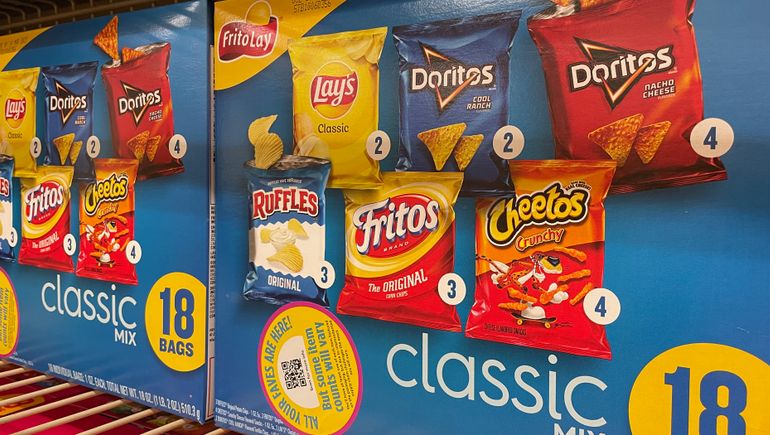|
Getting your Trinity Audio player ready...
|
PepsiCo has a “huge runway” to grow its multi-billion dollar snacking empire, despite owning a portfolio that includes decades-old favorites such as Doritos, Fritos and Cheetos among its best-selling offerings, a top executive said.
Parth Raval, chief growth officer for PepsiCo Foods North America, said the Texas-based division continues to “experiment and think about different” ingredients, packaging formats, flavors and unique combinations — such as the merging of salty and sweet — to strengthen its already dominant presence in the snacking category.
“We think about what sits outside of our core and that’s where we have a ton of excitement about the business” and our ability to capture a larger share of the snacking market, Raval said in an interview with sister publication Food Dive.
PepsiCo’s snacking business is composed mostly of Frito-Lay and Quaker Oats, which together generated nearly $22 billion in sales in North America during the company’s 2021 fiscal year — accounting for a little over a quarter of the CPG’s $79 billion in global sales.
Overall, the U.S. snacking market is valued at $115 billion, according to PepsiCo, giving the company roughly 20% ownership of the segment.
Brittany Quatrochi, an analyst at Edward Jones, called PepsiCo’s snack portfolio “a competitive advantage” and praised the work the company has done to keep its classic brands relevant through innovation. She pointed to new flavors, brand extensions such as dips, and the debut of different packaging sizes to better respond to the evolving needs of today’s consumer.
The CPG giant has also done an effective job of taking a global brand and localizing it to make it relevant in many different markets, Quatrochi said in an email, while simultaneously investing in smaller, emerging brands, which cater to faster-growing trends like healthier snacks.
“The snack portfolio and the investments PepsiCo has made to drive growth within snacks is a key driver in the company being a top-tier growth story within consumer staples,” Quatrochi noted.
Tapping growth from indulgent to healthy
A key part of PepsiCo Foods’ strategy to boost the reach of its snacking offerings came in response to the pandemic. The company created its growth office in late 2020.
The operation, which Raval oversees, was put in place to increase the efficiency of product development by bringing together different divisions throughout the company — from marketing and supply chain to formation and sales.
Optional Caption
Courtesy of Frito-Lay
A “must-have” in today’s environment, the growth office “allows us to be agnostic of any personal agenda” within a particular division at PepsiCo Foods, while helping the company overcome inevitable challenges that unfold in product development to create an offering that resonates with the consumer, Raval said.
“We’re seeing growth from our core of more indulgent products all the way to our much more health-forward products,” he said. “We’re very fortunate that we cover almost every daypart, from breakfast all the way through post-dinner, late-night snacking, across the broader PepsiCo portfolio.”
While PepsiCo Foods is best known for its chips, it also has a deep portfolio of other snacks such as Grandma’s cookies, Funyuns, PopCorners, Bare baked fruit and coconut snacks, Cracker Jack and Off the Eaten Path vegetable crisps. These give the company more options to meet an individual’s needs or preferences throughout the day. PepsiCo also deepened its presence in plant-based snacks through a joint venture with Beyond Meat. Jerky, the first product created from the partnership, hit store shelves in 2022.
Owning the day in snack choice
PepsiCo Foods has observed that not only are more consumers turning to snacking in place of meals, but when they choose to eat different options is changing, too. For example, Doritos chips are no longer only eaten around lunch, and Quaker granola bars are not seen as just for breakfast, Raval said. It’s caused the company to be more thoughtful in how it goes about commercializing its brands.
“In the past, we’ve had each of the individual businesses working in, if you will, silos, sort of saying, ‘Hey, listen, I own the afternoon daypart,’ ” Raval said. “Now what we’re trying to do is reorient our portfolio strategy across consumer needs and time of the day.”
Frito-Lay debuted Minis, bite-sized and portable versions of its classic Doritos, Cheetos and Sun Chips, last November. These increased the portability and snackability of the chips by packaging them in canisters. And a few months earlier, it rolled out a line called Tostitos Toppers. These bottles of sauces and dressings for meals brought the snack brand deeper into another eating occasion.

Optional Caption
Courtesy of PepsiCo
PepsiCo Foods has also observed more shoppers looking for multi-packs including several different snacking choices — like breakfast, salty, healthy and dessert. This trend gained momentum during the early months of the COVID-19 pandemic, and has accelerated since.
The company has responded by introducing items such as its Frito-Lay Family Time Mix, which includes Doritos, Munchies Crackers, Chewy Granola Bars and Cap’n Crunch’s Oops! All Mega Berries cereal snack pouches.
The company also has doubled down on where shoppers can buy its products.
In 2020, PepsiCo Foods launched two direct-to-consumer websites from which shoppers can order an assortment of products. One of them, Snacks.com, enables consumers to buy more than 100 of their favorite Frito-Lay products, including Lay’s, Tostitos, Cheetos and Ruffles, as well as dips, crackers and nuts.
Snacks.com not only provides Frito-Lay and Quaker with another way to reach the consumer, but created an outlet to sell harder-to-find brands or flavor extensions not carried on store shelves.
The platform also offers a valuable way for Frito-Lay and Quaker to observe consumer shopping behavior, such as how people assemble a basket of different snacks, or what they are looking for in a specific product. Executives overseeing the brands have observed from Snacks.com and retailer data that shoppers regularly gravitate toward products that are regionally focused or harder to find on store shelves.
“The way that demand gets generated is looking very different than it did even three years ago, and we expect that to accelerate going forward,” Raval said. Consumers “don’t just walk the aisles.”



